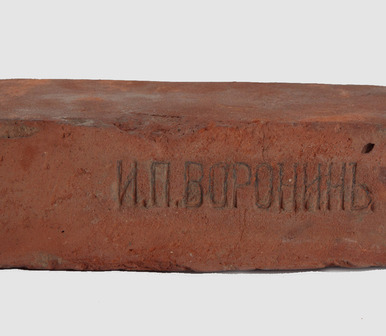The Mytishchi brick manufacturers made an enormous contribution to the construction of Moscow and the Moscow Region and the history of their land. The nature blessed them with large reserves of clay dated the Jurassic period. They allowed brick manufacturers of Mytishchi to constantly expand their capacity. Manufacturers rented land long-term only if its clay reserves were enough to last at least ten years at minimum production output of one million bricks a year.
The establish a factory with a capacity of one million bricks a year, one needed the startup capital of 10,000 rubles. The expenses paid off in three to four years. Often, manufacturers had to establish several factories or join capitals and create a joint-stock company. For example, this is how the brick factory of the merchant Alexei Gusarev and Vasily Chelnokov was established in 1871 on the land rented from peasants of the Sharapovo village.
Apart from the factory in Mytishchi, the honorary citizen Alexei Gusarev also owned a brick factory in the Lefortovo District of Moscow, near the Cherkizovo village. At the best of times, Gusarev’s Moscow factory produced up to 9 million bricks a year. In 1872, the succeeding manufacturer sold his factory in Moscow to the merchant Chelnokov.
Since the 1870s, Russia began to import brick production machinery from England, France, and Germany. However, not every manufacturer could afford a technical upgrade. Besides, maintenance was costly, too, and as a result, the cost of hand-molded and machine-molded bricks was almost the same. On top of it all, customers were suspicious about machine-made bricks because the quality of handmade bricks was generally better and manual production of bricks was polished to perfection.
On the cusp of 19th–20th century, Russia experienced an explosive growth of industry: more factories and plants were established, the railway network expanded quickly. However, Russia was still behind Europe and America in terms of brick production. The USA produced 150 bricks per person, England produced 90, Germany — 60, and Russia produced only 9.
The Moscow Governorate was the largest manufacturer of bricks in Russia. It produced about 140 million bricks a year, and the factories in Mytishchi alone supplied over 45 million bricks–almost 30% of the total amount manufactured in the Governorate. So it is no surprise that every third or fourth house and industrial facility in Moscow and the Moscow Region is made from the bricks produced by the factories of Mytishchi. We can see the proof of it in the brand marks on the bricks. The brand mark “A. Gusarev” can be seen in foundations of old houses in Sharapovka, the State Historical Museum of Moscow, the Moscow Polytechnic Museum, and the Tretyakov Drive.
The establish a factory with a capacity of one million bricks a year, one needed the startup capital of 10,000 rubles. The expenses paid off in three to four years. Often, manufacturers had to establish several factories or join capitals and create a joint-stock company. For example, this is how the brick factory of the merchant Alexei Gusarev and Vasily Chelnokov was established in 1871 on the land rented from peasants of the Sharapovo village.
Apart from the factory in Mytishchi, the honorary citizen Alexei Gusarev also owned a brick factory in the Lefortovo District of Moscow, near the Cherkizovo village. At the best of times, Gusarev’s Moscow factory produced up to 9 million bricks a year. In 1872, the succeeding manufacturer sold his factory in Moscow to the merchant Chelnokov.
Since the 1870s, Russia began to import brick production machinery from England, France, and Germany. However, not every manufacturer could afford a technical upgrade. Besides, maintenance was costly, too, and as a result, the cost of hand-molded and machine-molded bricks was almost the same. On top of it all, customers were suspicious about machine-made bricks because the quality of handmade bricks was generally better and manual production of bricks was polished to perfection.
On the cusp of 19th–20th century, Russia experienced an explosive growth of industry: more factories and plants were established, the railway network expanded quickly. However, Russia was still behind Europe and America in terms of brick production. The USA produced 150 bricks per person, England produced 90, Germany — 60, and Russia produced only 9.
The Moscow Governorate was the largest manufacturer of bricks in Russia. It produced about 140 million bricks a year, and the factories in Mytishchi alone supplied over 45 million bricks–almost 30% of the total amount manufactured in the Governorate. So it is no surprise that every third or fourth house and industrial facility in Moscow and the Moscow Region is made from the bricks produced by the factories of Mytishchi. We can see the proof of it in the brand marks on the bricks. The brand mark “A. Gusarev” can be seen in foundations of old houses in Sharapovka, the State Historical Museum of Moscow, the Moscow Polytechnic Museum, and the Tretyakov Drive.



